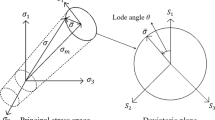Abstract
Computer experiments based on a drop-test model show that the ductile component in sample fracture is much reduced by a random factor—the weak link. The weak link (measuring a few mm) must be transverse to the sheet surface and in the direction of impact. The weak link may be the primary boundaries formed in melt solidification. These boundaries, which are rich in impurities, alloying elements, and nonmetallic inclusions, may be inherited by the hot-rolled metal. In some cases, their stability may result in impurity retardation.
Similar content being viewed by others
References
Kolbasnikov, N.G., Zotov, O.G., and Luk’yanov, A.A., Simulation of DWTT Tests for Steel and Proportion of Ductile Component in the Fracture, Nachn.-Tekhn. Vedom. SPbGPU, 2010, no. 4, pp. 335–341.
Borovkov, A.I., Nemov, A.S., Kolbasnikov, N.G., and Zolotov, A.M., Finite-Element Simulation and Investigation of Two-Bearing Impact Flexure of a Steel Sample to Determine Its Impact Strength, Nachn.-Tekhn. Vedom. SPbGPU, 2007, no. 3, pp. 53–58.
Bernshtein, M.L. and Zaimovskii, V.A., Mekhanicheskie svoistva metallov (Mechanical Properties of Metal), Moscow: Metallurgiya, 1979.
Kolbasnikov, N.G., Zotov, O.G., Duranichev, V.V., et al., Influence of Considerable Hot Deformation on the Structure and Properties of Low-Carbon Steel, Mashinoobrabotka, 2009, no. 4, pp. 25–31.
Kolbasnikov, N.G., Simulation of Impact-Strength Tests, Sb. materialov Tret’ei mezhdunar. konf. Deformatsiya i razrushenie materialov i nanomaterialov (Proceedings of Third International Conference on the Deformation and Failure of Materials and Nanomaterials), Bannykh, O.A., Ed., Moscow: Interkontakt Nauka, 2009, vol. 2, pp. 333–334.
Gorynin, V.I., Resistance of Manganese-Silicon Low-Carbon Steel with Laminar-Banded Structure to Brittle Failure, Metallov. Term. Obrab. Met., 2009, no. 3, pp. 33–37.
Heisterkamp, F. Hulka, K, Matrosov, Yu.I., et al., Niobiisoderzhashchie nizkolegirovannye stali (Low-Alloy Niobium Steels), Moscow: Intermet Engineering, 1999.
Rudskoi, A.I., Kolbasnikov, N.G., Borovkov, A.I., et al., Computer Simulation of the Impact Strength of Structurally Inhomogeneous Metals, Nachn.-Tekhn. Vedom. SPbGPU, 2011, no. 1, pp. 226–234.
Naumov, A.A., Development of Hot Rolling of Pipe- and Automotive-Steel Sheet by Physical and Mathematical Modeling, Cand. Sci. Dissertation, 2010.
Kolbasnikov, N.G. and Kondrat’ev, S. Yu., Entropiya. Struktura. Fazovye prevrashcheniya i svoistva metallov (Entropy, Structure, Phase Transformations and Properties of Metals), St Petersburg: Nauka, 2006.
Khvorinov, N.I., Kristallizatsiya i neodnorodnost’ stali (Solidification and Inhomogeneity of Steel), Moscow: Gos. Nauchn.-Tekhn. Izd. Mashinostroitel’noi Literatury, 1958.
Author information
Authors and Affiliations
Additional information
Original Russian Text © N.G. Kolbasnikov, O.G. Zotov, A.A. Luk’yanov, A.I. Shamshurin, 2011, published in “Stal’,” 2011, No. 10, pp. 53–60.
About this article
Cite this article
Kolbasnikov, N.G., Zotov, O.G., Luk’yanov, A.A. et al. The weak link in drop-test simulations. Steel Transl. 41, 865–872 (2011). https://doi.org/10.3103/S096709121110010X
Received:
Published:
Issue Date:
DOI: https://doi.org/10.3103/S096709121110010X




